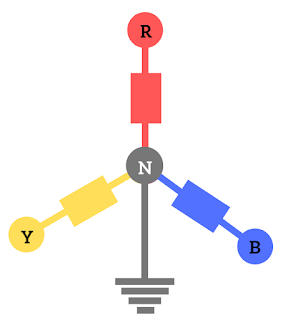Earthing and Grounding
Earthing
To connect the non-current carrying metal part of electrical equipment to the earth is known as Earthing. For example frame of the electrical equipment, enclosure etc.
To reduce the risk of an electric shock while touching the metal parts during fault condition is the main purpose of the Earthing. Green wire is generally used for earthing.
To reduce the risk of an electric shock while touching the metal parts during fault condition is the main purpose of the Earthing. Green wire is generally used for earthing.
Under the conditions of fault, non-current carrying metal part of electrical equipment may have high potential compared to the ground so that any person or homeless animals touching these will produce a potential difference. As a result, there may be a flow of current through the body of the person or the animal. This high value of current may prove fatal.
To carry the fault currents safely to the ground, non-current carrying metal parts of the electrical system are connected to the earth by using an earthing system.
Earthing has been done by connecting the metallic system to the Earth. It is normally obtained by putting the ground rods or other electrodes deep inside the earth.
Earthing is used to ensure the safety of the electrical equipment and the human by discharging the fault current to the ground.
All electrical circuits need a zero voltage as reference potential which is called the ground to make possible current flow from the generator to load. In Power distribution, it is either earthed at the distribution point or at the end of the consumer.
It is not necessary that neutral will always at ground potential. There may be neutral to ground voltage present due to voltage drop in the wiring.
To carry the fault currents safely to the ground, non-current carrying metal parts of the electrical system are connected to the earth by using an earthing system.
Earthing has been done by connecting the metallic system to the Earth. It is normally obtained by putting the ground rods or other electrodes deep inside the earth.
Earthing is used to ensure the safety of the electrical equipment and the human by discharging the fault current to the ground.
Grounding
To connect the live part which carries currents under normal condition (neutral of power transformer) to the earth is called grounding.
It provides protection to power system equipment and also offer return path from machine to the power source.The grounding refers to the current carrying part of the system like neutral of transformer or generator.
Because of lightning, line surge or accidental contact with other high voltage lines, dangerous high voltage can develop within the power distribution systems. Grounding offers safe, an alternative way around the electrical system of your home and reduces the damage from such incidents. Usually, black wires are used for grounding.All electrical circuits need a zero voltage as reference potential which is called the ground to make possible current flow from the generator to load. In Power distribution, it is either earthed at the distribution point or at the end of the consumer.
It is not necessary that neutral will always at ground potential. There may be neutral to ground voltage present due to voltage drop in the wiring.
In balanced system, the currents in one phase balance by another phase, therefore the total neutral current is zero. This is not totally possible for individual systems. however, we try to come close to zero.




